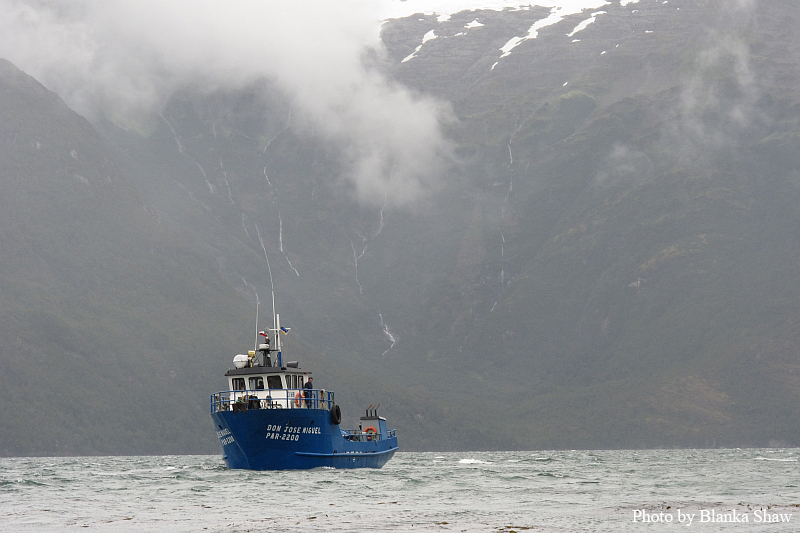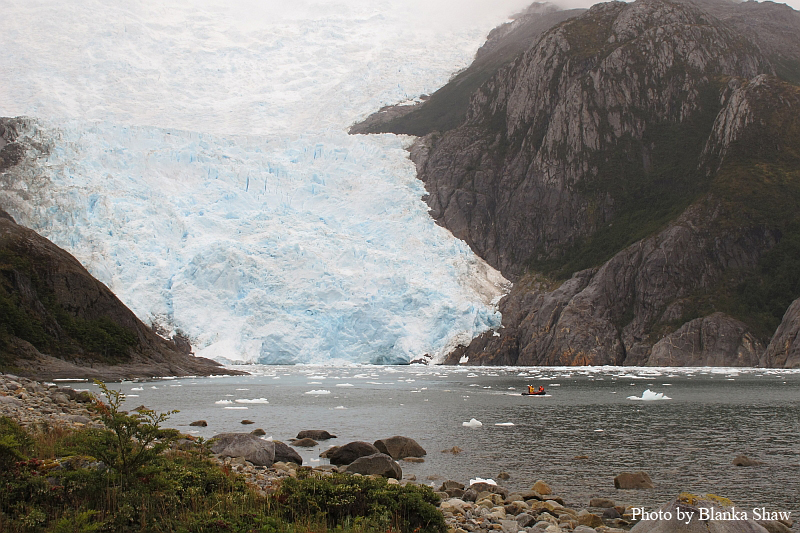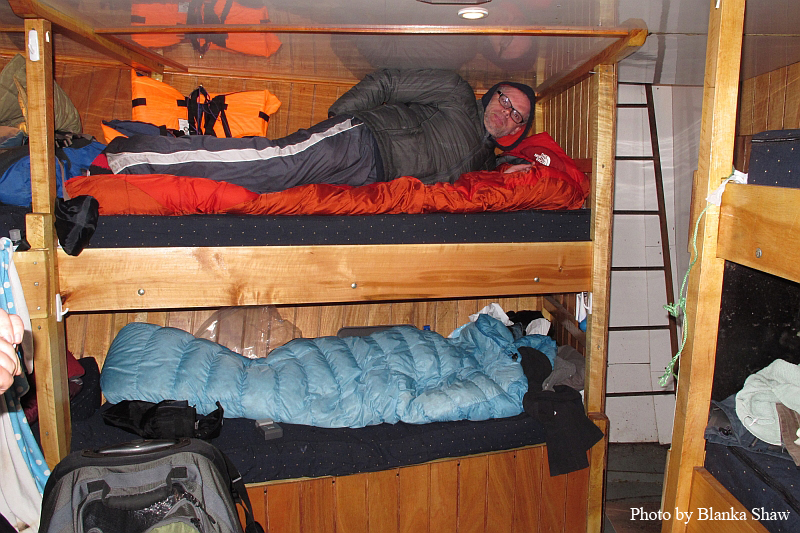From the Field: Bill Buck in Cape Horn, Day 11
Posted in Bill Buck, From the Field, Science on February 21 2012, by William R. Buck
January 30, 2012; Isla Gordon, Bahía Romanche, 54º57’S, 69º30’W

What a difference a day makes! We anchored last night in Caleta Olla (approximately 54º56’S, 69º09’W) and for the first night of the trip we could see the Southern Cross and many more of the bright stars that illuminate the Southern Hemisphere’s night sky. But by morning it was completely overcast with a cold wind spitting light rain. Today, we were hoping to hit three localities rather than our standard two, the first being Caleta Olla itself. The group spread out to hit the various habitats, including a beaver-disturbed peatland and various forest types, while I chose to collect along an extensive cliff base not far from the harbor. It was not the richest cliff face I have seen, but it occupied me for well over an hour, and I even had time to make a few large collections of pleurocarps for Bernard Goffinet‘s genomic work. However, I was anxious to get to our next site, Glacier Italia.
Several years ago I blindly collected a lichen by reaching my hand into an icy, glacier-fed waterfall. Feeling the rocks behind it, I was hoping for mosses, but took what I could find. And what I could find turned out to be a species of Peltigera new to science. The group at Duke University to whom I had given it (led by Jola Miadlikowska) wanted additional material.
So finding another specimen of this lichen was my primary goal at Glacier Italia. It is a large glacier that comes right down to the sea. Initially I was let off on a beach near the mouth of a small bay and started walking toward the glacier. As I was heading toward the glacier, I noticed two of the crew in a Zodiac giving Ernesto a closer look at the frequently calving glacier. I reached the point where Ernesto had gone ashore and where the two crew members still were. I asked about getting to the waterfall next to the glacier, and they told me that I wasn’t going to reach it on foot, but that they could get me there in the Zodiac. Thus began our icy adventure.
Shortly after Ernesto and I boarded the zodiac and headed into the harbor, the glacier calved a huge iceberg, which created a tsunami-like effect in the small bay. The crew member at the motor decided to keep the small inflatable craft in the middle of the harbor as the wave approached and we experienced only a large swell as the waves crashed violently against the shore as the tsunami-ette moved down the harbor. As the waters calmed, we were again able to continue our journey, though we now had to avoid the largest of the ice chunks in the water. We soon tied up near the glacier and Ernesto and I headed for the waterfall. Soon, though, I realized I wasn’t prepared to continue; the slope was very steep and incredibly slippery from the steady rainfall.

So, I decided that the new lichen would remain known from only a single, lucky collection and that it was time for me to head back to the Zodiac. Ernesto, however, had other ideas, so he went ahead. I worked my way back toward the Zodiac, collecting as I went. By the time I arrived back at the shore, it was already late, and Ernesto was nowhere to be seen. The crew started calling for him and I began to worry that he might have injured himself, lichen be damned. But finally after many, paranoia-filled minutes, Ernesto came into view, empty-handed. However, our relief would be short lived.
By the time we were ready to leave, the wind had shifted and blown much of the ice back into the harbor, essentially encasing our Zodiac in ice. Thoughts of the Titaniccame to mind as we slowly motored through the iceberg-covered waters. One of the crew stood on the bow of the Zodiac, pushing aside the larger chunks of ice with a long pole. In time we escaped the ice and made our way to the beach where the other members of our group awaited. The water near the beach was shallow with many large, submerged rocks. Our captain, becoming increasingly worried by the tricky conditions, moved the ship closer to us. Earlier in the day when we had piled into the Zodiac to go ashore, the captain had mandated that only five people be allowed in the Zodiac at any one time, due to the rough seas. And now the seas were even rougher, but the crew wanted everyone back on the ship, so all eight of us filled the tiny Zodiac. Soon after setting out for the ship, we hit a large, submerged rock that all but knocked us into the water. The ship was in view and we didn’t see any water entering the Zodiac; large, icy waves crashed into the inflatable boat. It was hairy, but we made it back to the ship. Once on-board, we learned that the Zodiac had suffered from our rock strike–there was a good-sized hole in the bow. Fortunately, we seem to have a repair compound on board.
By that time the seas had gotten rougher and there was no way to be able to disembark at our next scheduled stop. The captain called me up to the bridge to discuss the change in plans and we decided to head to a sheltered cove for the night, ultimately ending up in the same bay where we stopped for water yesterday. For most of us, anchorage at around 5 p.m. gave us a chance to process the great volume of wet specimens we had collected earlier in the day. Not surprisingly, however, the person addicted to collecting (Blanka), and the absolute collecting machine (Xiaolan), wanted to go out again, and so they were taken to the field.
I have learned from unfortunate experience that improperly dried material can become moldy and thus lose much of its scientific value, and so I chose to number my collections and get them on the dryer as soon as possible. Blanka and Xiaolan have either never had similar experiences, or have faith they’ll be able to get everything processed later tonight. I don’t intend to stay up and find out! Last night one of the crew moved into our bunk room and his head was only a foot or so from mine. All night long he snored continuously, and because they had turned off the generator there was no other noise to drown him out. I lay awake most of the night listening to the snoring. Tonight I’m making sure that generator stays on, both to get the specimens dry and to ensure a good night’s sleep.

I’m not sure what tomorrow will bring. We’ve had to pass by our next few planned stops, but hope to backtrack if possible. As always, we’re at the mercy of the weather.
Ed. note: NYBG scientist and Mary Flagler Cary Curator of Botany, Bill Buck is currently on expedition to the islands off Cape Horn, the southernmost point in South America, to study mosses and lichens. Follow his journeys on Plant Talk.
Bill Buck’s Previous Reports From the Field:
2012
January 25, 2012; Isla Darwin, Caleta Virginia, approximately 54º57’S, 70º10’W
January 23, 2012; Arm of Estero Webb, SW coast of Isla Hoste, approximately 55º14’S, 69º41’W
January 22, 2012.; Unnamed sound on Isla Gordon behind Cabo El Gorro, approximately 55º02’S, 69º48’W
January 21, 2012; Isla Hoste, Estero Fouque, 55º1’S, 69º35’W
January 20, 2012; Isla Hoste, Estero Fouque, approximately 55º11’S, 69º35’W
January 18, 2012; Canal O’Brien, just south of Isla O’Brien, 54º55’S, 70º35’W
January 17, 2012; Punta Arenas, Chile
2011
July 15, 2011; Hobart, Tasmania, Australia
July 14, 2011; Pyengana, Tasmania, Australia
July 13, 2011; Weldborough, Tasmania, Australia
July 12, 2011; Hobart, Tasmania, Australia
July 11, 2011; Hobart, Tasmania, Australia
February 8, 2011; Punta Arenas, Chile
February 5, 2011, unnamed sound northwest of Isla Georgiana
February 4, 2011, unnamed sound directly east of Seno Mama, Chile
February 2, 2011, Seno Courtenay, northern arm, Chile
February 1, 2011, Seno Courtenay, Chile
January 31, 2011, Canal between Isla Georgiana and Isla Clementina,, Chile
January 30, 2011, Unnamed sound on south side of Brecknock Peninsula, NW of Isla Georgiana, Chile
January 29, 2011, Isla Aguirre, Seno Quo Vadis, Chile
January 26, 2011, Punta Arenas, Chile
January 24, 2011, Seno Chasco, just north of isthmus to Brecknock Peninsula, Chile
January 23, 2011, Isla Grande de la Tierra del Fuego, Puerto Consuelo, Seno Chasco, Chile
January 22, 2011, Isla Grande de la Tierra del Fuego, Seno Brujo, Chile
January 21, 2011, Isla Grande de la Tierra del Fuego, Seno Brujo, Chile
January 20, 2011, Isla Grande de la Tierra del Fuego, Seno Bluff, Chile


Thank you for another magnificent article. Where else may anybody get that kind
of info in such an ideal manner of writing?
I have a presentation next week, and I am on the search for
such info.